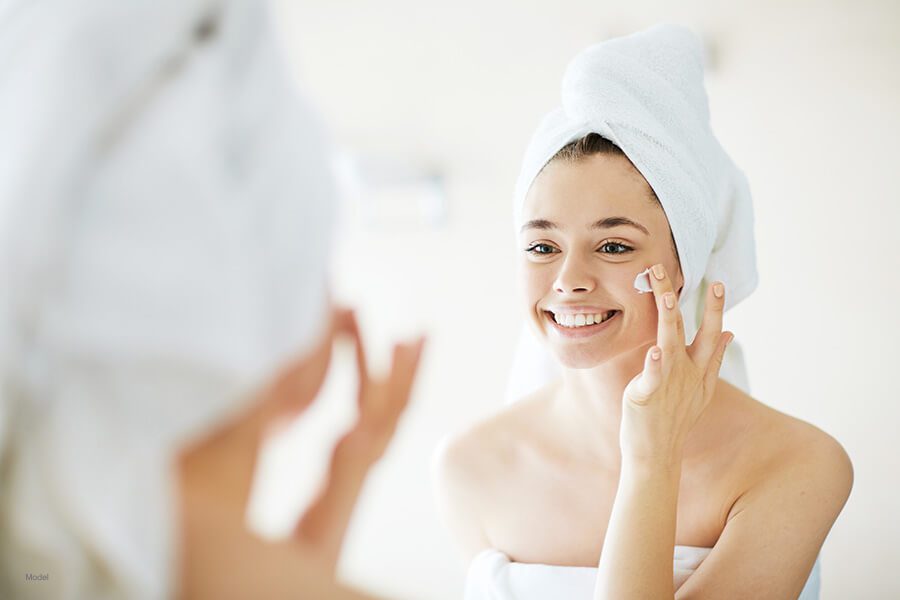What’s the Difference Between a Laser Peel and a Chemical Peel?
Chemical Peels, Laser Peel | The Office of Dr. Vincent Hung

Individuals seeking skin resurfacing have several options, with two of the most popular being chemical and laser peels. Each method offers unique benefits and works through different mechanisms to improve the skin’s texture and appearance, addressing wrinkles, poor skin texture, and some types of skin discoloration. This blog will explore the differences between laser and chemical peels so you can make a well-informed decision about which is best for your skin needs and aesthetic goals.
5 Min Read:
What is a Laser Peel?
Glowing, dewy skin is what so many long to have. A laser peel, also known as laser skin resurfacing, delivers concentrated beams of light to remove the outer layers of the skin. This process promotes the generation of new, healthier skin cells and encourages collagen production, which can enhance skin firmness and elasticity. There are different types of lasers used in laser peels, each with specific functions and benefits:
Ablative Lasers
Ablative lasers, such as CO2 and erbium lasers, remove the outer (older) layer of skin (epidermis) and heat the underlying layers (dermis) to stimulate collagen and healthy new skin growth. This type of laser peel is more intensive and requires a longer recovery time, but it can provide dramatic results when addressing:
- Deep wrinkles
- Severe sun damage
- Significant skin texture issues
Non-Ablative Lasers
In contrast, non-ablative lasers, like Nd:YAG and fractional lasers, don’t remove the outer layer of skin. Instead, they target deeper layers of the skin to promote collagen growth and skin tightening. Non-ablative laser peels are less invasive and have shorter recovery times, making them suitable for those with milder or more moderate skin concerns such as:
- Fine lines
- Mild pigmentation
- Early signs of aging
What is a Chemical Peel?
Using a liquid solution applied to the skin, a chemical peel causes the outer layers to eventually peel off. This process reveals new, smoother skin underneath. Chemical peels vary in strength and depth, depending on the type of acid used and the desired results:
Superficial Peels
Mild acids like alpha hydroxy acids (AHAs) or beta hydroxy acids (BHAs) are used in superficial peels to gently exfoliate the uppermost layer of the skin. These peels are ideal for addressing minor skin imperfections such as:
- Uneven texture
- Dullness
- Mild acne
The recovery time for superficial peels is minimal, often just a few days of slight redness and peeling.
Medium Peels
Typically using trichloroacetic acid (TCA), medium peels can penetrate deeper into the skin and address more significant concerns like:
- Fine lines
- Acne scars
- Moderate sun damage
The recovery period for a medium peel is longer than that of a superficial peel, with noticeable peeling and redness lasting about a week.
Deep Peels
Deep peels use strong acids like phenol to achieve profound skin resurfacing. These peels can correct:
- Deep wrinkles
- Severe sun damage
- Significant scarring
Due to their intensity, deep peels require a lengthy recovery period, often of several weeks. It should only be performed by qualified and experienced professionals to lower the risk of complications.
Key Differences Between Laser Peels and Chemical Peels
The Way Cosmetic Peels Work
The primary difference between laser peels and chemical peels lies in how they achieve skin resurfacing. Laser peels use light energy to vaporize the skin’s outer layers and stimulate collagen production.
In contrast, chemical peels rely on applying acidic solutions to chemically exfoliate the skin. This fundamental difference in approach affects the depth of penetration, type of results, and recovery time for each treatment.
Precision and Customization
Laser peels offer a high degree of precision and customization. The intensity of the laser is adjustable to target specific skin concerns, making it possible to treat different areas of the face with varying degrees of intensity. This versatility makes laser peels appropriate for a more tailored treatment that can address both superficial and deep skin issues in a single session.
Chemical peels, while also customizable to some extent, primarily depend on the type and concentration of the acid used. The depth of penetration is less easily controlled compared to laser peels.
Skin Concerns Addressed
Both laser peels and chemical peels can address a range of skin concerns, but their effectiveness varies depending on the issue:
- Wrinkles and Fine Lines: Ablative laser peels are best for deep wrinkles and noticeable skin laxity, while chemical peels can address fine lines and moderate wrinkles.
- Pigmentation and Sun Damage: Both treatments can reduce pigmentation and sun damage, but laser peels, especially fractional lasers, can be more effective for deeper pigmentation issues.
- Acne and Acne Scars: Superficial and medium chemical peels commonly treat acne and superficial acne scars. Laser peels can also address acne scars, with fractional lasers being particularly effective.
- Skin Texture and Pore Size: Laser peels can significantly improve skin texture and reduce pore size through collagen stimulation. Chemical peels also improve texture but may not be as effective for large pores.
Risk and Side Effects
Both laser and chemical peels carry risks and potential side effects. Laser peels can cause redness, swelling, and infection if not properly managed. There is also a risk of discoloration, especially in individuals with darker skin tones. Chemical peels can cause redness, peeling, and sensitivity, with deeper peels carrying risks of scarring and changes in skin pigmentation. It is essential to have laser and chemical peels performed by qualified aesthetic healthcare professionals to minimize risks and ensure proper aftercare.
Choosing a Chemical Peel or a Laser Peel in Pasadena, CA
Deciding between a laser peel and a chemical peel depends on various factors, including skin type, specific concerns, desired results, and willingness to endure downtime. Consulting with a dermatologist or qualified skin care professional is paramount in determining the most appropriate treatment based on your unique concerns and goals.
Our plastic surgeon, Dr. Vincent Hung, is a leader in his field and is also board-certified in dermatology. Schedule a consultation today to learn more about your Pasadena chemical and laser peel options by calling (626) 623-7135, or for our Newport Beach office, call (949) 415-5195.

